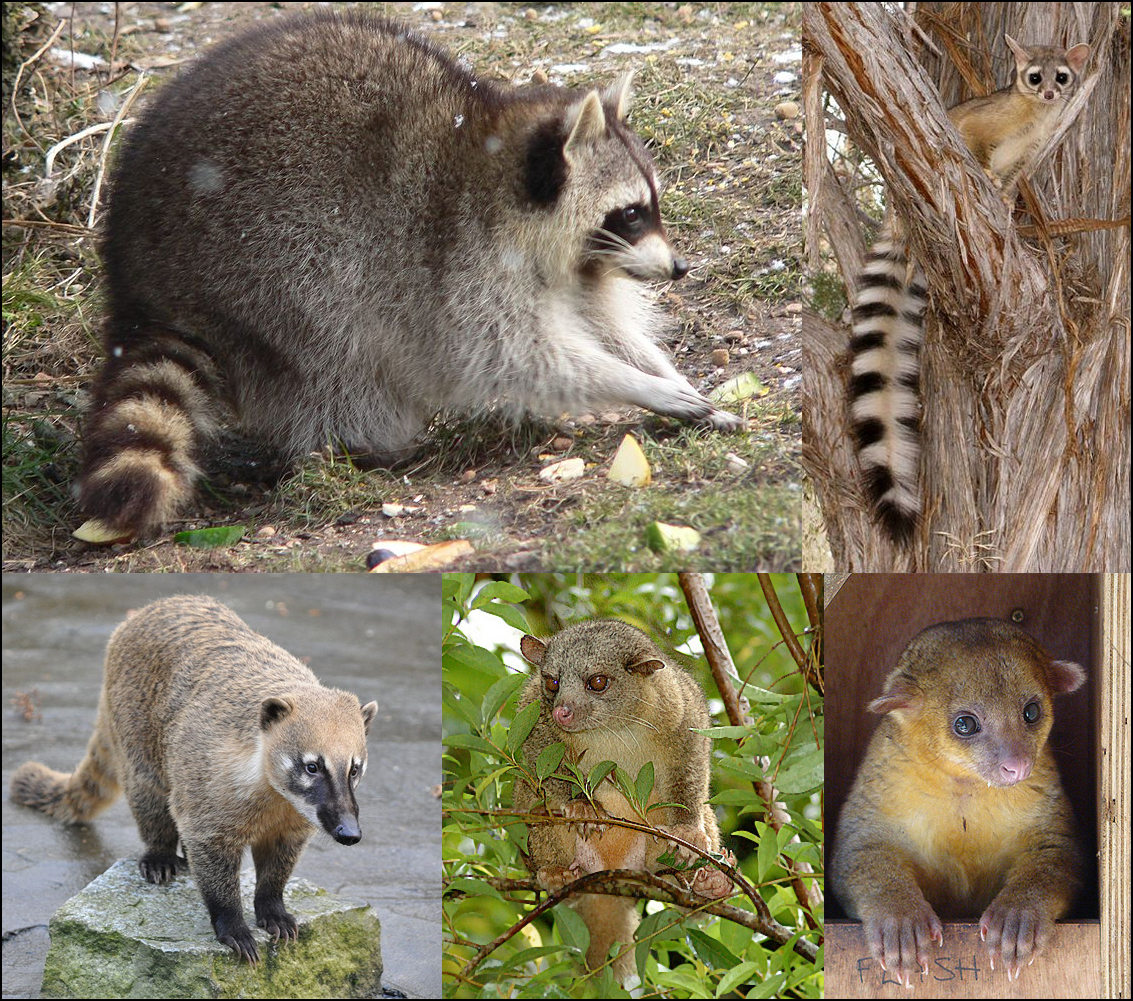Facts for Kids
Procyonidae is a family of clever mammals from the order Carnivora, including raccoons, coatis, and kinkajous, known for their dexterous paws and varied diets.
Overview
Fun Facts
Related Species
Diet And Feeding
Conservation Status
Behavior And Ecology
Cultural Significance
Habitat And Distribution
Physical Characteristics
Reproduction And Lifespan
Taxonomy And Classification

Inside this Article
Sense Of Smell
South America
Mustelidae
Population
Costa Rica
Carnivora
Spring
People
Nature
Black
Food
Did you know?
🦝 Raccoons, coatis, and kinkajous are all part of the Procyonidae family!
🌎 Procyonidae animals are found mostly in North and South America.
🚀 The name 'Procyonidae' means 'before the dog' in Greek.
🐾 Raccoons are known for their distinctive black masks around their eyes.
🌙 Procyonids are often nocturnal, meaning they are active at night.
🍌 Kinkajous love eating fruits, especially bananas and figs.
🌳 Coatis prefer tropical forests and are often seen in groups.
🎓 Raccoons can possess intelligence similar to dogs and have excellent memories.
🌟 Procyonids play vital roles in their ecosystems, helping to spread seeds.
🗑️ Raccoons are often described as 'nature's garbage disposals' due to their varied diet.
Introduction
These fun critters are found mostly in North and South America. They are known for their cleverness and the way they use their front paws like hands! Procyonids come from the order Carnivora, but they often munch on fruits and nuts, too! These furry friends are social and enjoy living in groups called troops. Did you know that raccoons can be as smart as a dog? 🎓
They even have excellent memories! Join us as we learn about their cool world and how they live! 🌎
Fun Facts
They are super smart and can even remember how to solve puzzles for food! Also, kinkajous have a special "vocal" ability called "coughing" to communicate with each other.
Coatis have a long snout that helps them sniff out food quickly! 🌬
️ Another fun fact is that raccoons can rotate their hind feet, which helps them climb down trees headfirst! 🤸
♂️ Procyonids are full of surprises, making them one of nature's coolest families! Keep exploring to find out even more! 🌟
Related Species
Some of their close relatives include weasels, otters, and ferrets, all belonging to the Mustelidae family.
Despite being different, these species share some common traits, like sharp teeth and claws! Raccoons and their relatives also share a love for water, as many hunt in rivers and streams. Being part of this larger family helps Procyonids connect with other fascinating carnivores, showcasing the diversity of the animal kingdom! 🌈
Diet And Feeding
️ Coatis mainly eat fruits & insects but also like to munch on small animals.
On the other hand, kinkajous love fruit, especially sweet bananas and figs. 🍌
These critters have special teeth that help them crush their tasty meals! With their incredible sense of smell and dexterous paws, they are excellent foragers! 🌟
Their eating habits help spread seeds and keep forests balanced.
Conservation Status
Coatis are more vulnerable because they need specific forest environments that are disappearing due to deforestation.
Kinkajous are also impacted by habitat loss and poaching for the pet trade. Organizations are working hard to protect their habitats 🏞️ by creating reserves and promoting awareness. Every little bit helps to ensure that these fantastic animals continue to thrive in their homes!
Behavior And Ecology
Coatis have social structures where all females and their babies stay together, while males prefer to be alone!
Raccoons are super smart and can solve puzzles to get food, showing off their problem-solving skills! 🧩
Kinkajous communicate using sounds like chirps, whistles, and even growls. Their playful nature is contagious, making them fun to observe in their habitats! Every member of this family plays an important role in their ecosystem.
Cultural Significance
Coatis are considered important in some South American cultures, while kinkajous charm people with their playful behavior! 🎉
Additionally, they're sometimes called "honey bears" because they love to eat honey. Procyonids enrich our tales and traditions, teaching us about the wonders of nature! 🐻✨
Habitat And Distribution
Coatis love tropical forests and can be spotted in places like Costa Rica and Brazil.
Kinkajous prefer the warm, humid rainforests of Central and South America. Their homes are filled with trees that provide food and shelter. 🌳
These animals often climb high in trees to stay safe from predators. Each species has adapted to its environment, demonstrating nature's wonderful variety!
Physical Characteristics
Kinkajous have longer bodies and can grow about 16 to 24 inches (40 to 60 cm) long.
Their limbs are strong, and they have sharp claws 🐾 that help them climb trees and dig. Coatis have long snouts that help them sniff out food, and their tails are often held high like a flag! 🎉
Each animal in the Procyonidae family has unique fur colors and patterns, making them stand out wherever they go!
Reproduction And Lifespan
The mother is very protective and cares for them until they are about 6 months old. Coatis also have litters, typically giving birth to 1 to 7 young, usually during the rainy season.
Kinkajous can have babies any time of year, but they usually have one baby at a time. 🍼
Interestingly, raccoons can live up to 5-7 years in the wild, while in captivity, they can live up to 15 years or more! Knowing about their life cycles helps us appreciate the importance of protecting these amazing animals!
Taxonomy And Classification
The family includes several species, with raccoons (Procyon lotor) being the most famous! Other fun members are coatis (Nasua narica), kinkajous (Potos flavus), and olingos (Bassaricyon spp.).
The name "Procyonidae" comes from Greek, meaning "before the dog" 🐶, since they share common ancestors. Scientists organize animals into groups called taxa, which help us understand how they are related. Each species has its own special traits, making the Procyonidae family super interesting!

